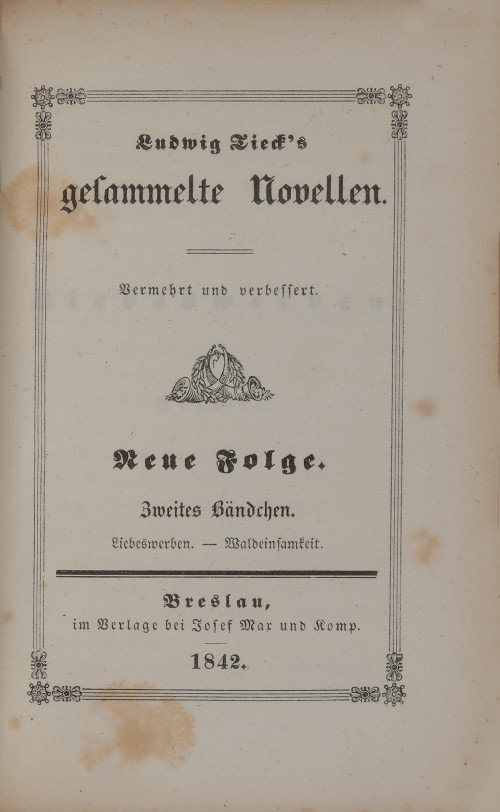Three volumes make up the collection of Volksmährchen, or folk fairy tales. The author was Ludwig Tieck; he published it, however, under the pseudonym Peter Leberecht. The title was meant to create the impression of texts passed down by word of mouth. In fact, Tieck here combined existing material with freely invented stories. From the strictly literary point of view, they are therefore “Kunstmärchen”, or “art fairy tales”. The “fairy tale” already existed as a genre before Romanticism, when it was defined as a didactic story enhanced with supernatural elements. Especially in the Enlightenment period, literature was supposed to be instructive. Tieck alluded to this tradition with the name “Leberecht”, which translates literally as “Live Right”. It was in Romanticism that fairy tales first came to be appreciated for their folkloristic qualities.
Of all the tales in Tieck’s Volksmährchen collection, “Fair-Haired Eckbert" became especially well known. The story plays out for the most part in the forest. One frequently recurring word is “Waldeinsamkeit”, or “forest solitude”, a melodious blend of natural impression and affective sensation. In fact, “Waldeinsamkeit” would become a way of referring to the fairy-tale-like bond between the human being and nature in general. Nevertheless, this romantic conception of harmony remained problematic: It is a state that can only be attained at the cost of complete withdrawal from society. As the story unfolds, the element of the uncanny comes ever more to the fore. The main characters end up entangled in jealousy, incest, and madness.
This display in the small separate room alludes to the two contrasting aspects of the forest experience the idyllic and the eery. Sudden shifts of perspective, causing an entirely different perception of the world, are typical of Romanticism.
Tieck’s coinage “Waldeinsamkeit” quickly caught on. The German authors Joseph von Eichendorff and Heinrich Heine and the American Ralph Waldo Emerson all made use of it. Tieck himself also returned to it in his last novella, dated 1840, when he elevated it to the status of a title: Waldeinsamkeit.
Objects
-

ROBERT SCHUMANN
Vogel als Prophet, 1849
-

LUDWIG TIECK
Volksmährchen herausgegeben von Peter Leberecht
Band 1 (von 3). Berlin: Carl August Nicolai 1797. S. 191–242: Der blonde Eckbert.
-

JOHANN KARL AUGUST MUSÄUS
Volksmährchen der Deutschen
Gotha: Ettinger 1787/88.
-

LUDWIG TIECK
Ludwig Tieck’s gesammelte Novellen
Band 12 (= Neue Folge, Band 2): Liebeswerben ‒ Waldeinsamkeit. Breslau: Max 1842.